
| Palaeos |  |
Glossary |
| Fungi | Glossary A |
| Page Back | Unit Back | Fungi | Dendrogram | References | Taxon Index | Pieces |
| Page Next | Unit Next | Unit Home | Unit Dendrogram | Unit References | Glossary | Time |
The initial entries in this glossary were assembled in considerable haste. I tender my apologies to Jonathan Dixon, late of the University of Manchester, from whose glossary I borrowed liberally. Various other gleanings are credited individually.
Anamorph: the asexual reproductive or propogative manifestation of a fungus.
Anomer: See, The Cell Wall.
Apomorphy: a character state which is unique to a single, terminal taxon. Example: among primates, complex grammar is an apomorphy of human beings. It is quite diagnostic of humans, but useless in determining phylogenetic relationships because it is not a shared, derived characteristic, or synapomorphy, of any larger group.
Apothecial: pertaining to apothecia
 Apothecium:
a disk-shaped or cup-shaped ascocarp (fruiting body) of
a lichen or non-lichenized ascomycete.
In an apothecium, the asci are born in a single, orderly layer on an open,
fairly flat surface. Image of apothecium from Mollisia dehnii from the Univ.
of Wisconsin -- Madison Botany Department web site.
Apothecium:
a disk-shaped or cup-shaped ascocarp (fruiting body) of
a lichen or non-lichenized ascomycete.
In an apothecium, the asci are born in a single, orderly layer on an open,
fairly flat surface. Image of apothecium from Mollisia dehnii from the Univ.
of Wisconsin -- Madison Botany Department web site.
Arthrospore: A spore resulting from the fragmentation of a hypha.
Ascocarp: the fruiting body of an ascomycete; the multicellular structure that produces asci, and acts as the platform from which the spores are launched.
Ascohymenial: relating to an ascocarp which forms after nuclear pairing. The ascocarps produced by ascohymenial development extend out into the medium, as in the image at apothecium, and the asci are unitunicate. Comapare ascolocular.
Ascolocular: relating to a mode of ascocarp growth in which a perithecium develops within a cushioning hollow of cells (the stroma) which is nested in a depression of the hymenium (a locule). The ascocarps produced by ascolocular growth do not grow into the medium, and the asci are usually bitunicate. Compare ascohymenial.
Ascoma: (pl. ascomata) (1) same as ascocarp (2) "an ascocarp having the spore-bearing layer of cells (the hymenium) on a broad disklike receptacle." This latter definition is frequently cited but appears to be either incorrect or useless. For our purposes, ascoma and ascocarp will be treated as synonymous.
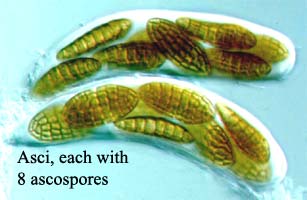 Ascospore: A meiospore borne in an ascus
Ascospore: A meiospore borne in an ascus
Ascus: a sac-like cell containing the ascospores cleaved from within by free cell formation after karyogamy (nuclear fusion) and meiosis. Eight ascospores typically are formed within the ascus, but this number may vary considerably.
Autotroph: an organism which obtains energy from inorganic sources, sunlight or the oxidation of inorganic chemicals.
Ballistospory: the ability to launch spores into the air. The mechanism of ballistospory is not fully understood. This ability is common in Basiodiomycota and is also known in some Ascomycota.
Basidiospore: a meiospore borne on the outside of a basidium.
Basidium: structure produced by basidiomycetes on which sexual spore formation occurs.
Binding hyphae: thick walled, typically aseptate, highly branched vegetative hyphae.
Bitunicate: an ascus with differentiated inner and outer walls is said to be bitunicate. See also, fissitunicate.
Budding: reproduction by binary fission, a characteristic form of propogation in yeasts. "The onset of the cellular events is accompanied by the nuclear events of mitosis. ... The initial events of budding can be seen as the development of a ring of chitin around the point where the bud is about to appear. This reinforces and stabilizes the cell wall. Enzymatic activity and turgor pressure the act to weaken and extrude the cell wall. New cell wall material is incorporated during this phase. Cell contents are forced into the progeny cell, and as the final phase of mitosis ends a cell plate, the point at which a new cell wall will grow inwards from, forms." http://www-micro.msb.le.ac.uk/224/mycology/2.html (former site)
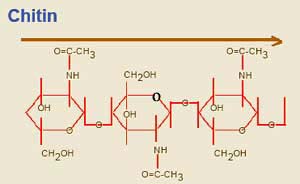 Chitin:
a polymer of repeating sugar molecules (a slightly modified glucose,
poly-N-acetyl-D-glucosamine). See image. Chitin is the material which makes up the
exoskeleton of insects and, in more or less modified form, in almost all arthropods. In arthropods, chitin occurs in a crosslinked form, α-chitin.
Significantly, it is also found in the radular "teeth" of molluscs,
the setae (bristles) and jaws of annelid worms, and the cell walls of Fungi. So,
this is exceedingly ancient stuff, possibly predating the split between bacteria
and metazoans. [What may be of sociological interest is that the 1,5
aldose linkage was missing from the middle glucose in this diagram and no one
spotted it for over a year ....]
Chitin:
a polymer of repeating sugar molecules (a slightly modified glucose,
poly-N-acetyl-D-glucosamine). See image. Chitin is the material which makes up the
exoskeleton of insects and, in more or less modified form, in almost all arthropods. In arthropods, chitin occurs in a crosslinked form, α-chitin.
Significantly, it is also found in the radular "teeth" of molluscs,
the setae (bristles) and jaws of annelid worms, and the cell walls of Fungi. So,
this is exceedingly ancient stuff, possibly predating the split between bacteria
and metazoans. [What may be of sociological interest is that the 1,5
aldose linkage was missing from the middle glucose in this diagram and no one
spotted it for over a year ....]
Chitosan: Chitosan (poly-D-glucosamine) is one of the most common polymers found in nature. Structurally, it is related to cellulose, which consists of long chains of glucose molecules linked to each other. Chitosan is chitin with acetic acid amide linkage hydrolyzed from the 2-amino group. In fact, this is exactly how chitosan is commercially prepared.
Clade: a "natural group" or phylogenetically defined group of organisms. A clade is usually defined as a particular organism "and all of its descendants." This apparantly innocuous concept, introduced to systematics by Willi Hennig, has completely changed the way systematics is done and has fundamentally altered the way we view evolutionary change. To understand why, see Dendrograms.
 Clamp connection: a
bridge-like hyphal connection involved in maintaining the dikaryotic condition.
There's a great animation of this process at Forest
and Shade Tree Pathology. Another explanation, from Prof. George
Wong's site at the University of Hawaii (see image): "a. Terminal cell
of hypha. Growth only takes place at hyphal tips; b. Hyphal tip elongating. c.
Synchronous division of nuclei and the beginning of hyphal branch that will
become the clamp connection. One nucleus (b) migrates into the new clamp. d.
Septum forms at base of the clamp trapping nucleus b. Nuclei a' and b' migrate
to the hyphal tip, while nucleus a migrates away from the tip. e. Septum forms
below clamp forming new cell at hyphal tip. Fusion of the clamp to the adjacent
cell releases nucleus b to the adjacent cell. Now both the terminal and
subterminal are binucleate, each with a compatible pair of nuclei."
Clamp connection: a
bridge-like hyphal connection involved in maintaining the dikaryotic condition.
There's a great animation of this process at Forest
and Shade Tree Pathology. Another explanation, from Prof. George
Wong's site at the University of Hawaii (see image): "a. Terminal cell
of hypha. Growth only takes place at hyphal tips; b. Hyphal tip elongating. c.
Synchronous division of nuclei and the beginning of hyphal branch that will
become the clamp connection. One nucleus (b) migrates into the new clamp. d.
Septum forms at base of the clamp trapping nucleus b. Nuclei a' and b' migrate
to the hyphal tip, while nucleus a migrates away from the tip. e. Septum forms
below clamp forming new cell at hyphal tip. Fusion of the clamp to the adjacent
cell releases nucleus b to the adjacent cell. Now both the terminal and
subterminal are binucleate, each with a compatible pair of nuclei."
Cleistocarp: same as cleistothecium
Cleistothecial: of an ascocarp (especially Aspergillaceae and Erysiphaceae), have a closed spore-bearing structure without a pore (ostiole) for spore release, and from which spores are released only by decay or disintegration.
Cleistothecium: a cleistothecial ascocarp.
Coenocytic: only divisions (septa) are formed between the nuclei of the hypha when reproductive cells develop.
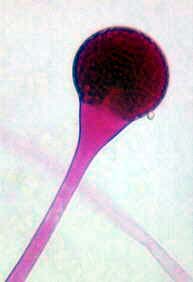 Columella:
the swollen tip of the sporangiophore (the stalk)
on which mitospores develop. The image shows
an intact columella, with spores attaches. When the spores have dispersed,
the columella collapses into a structure that looks remarkably like a
microscopic mushroom.
Columella:
the swollen tip of the sporangiophore (the stalk)
on which mitospores develop. The image shows
an intact columella, with spores attaches. When the spores have dispersed,
the columella collapses into a structure that looks remarkably like a
microscopic mushroom.
Colony: coherent mycelium or mass of cells, like yeast cells, of one origin.
Conidium: Conidia are sporangia grown on elaborate structures called conidiophores. These are usually stalked, lifting the conidia off the substrate for better dispersal and to avoid microscopic grazing animals. They are often produced hundreds or thousands of at a time.
Crista: (pl. cristae) (1) of mitochondria, folds in the internal membrane of the mitochondrion which gives the organelle its characteristic appearance. This is the site of the electron transport chain in oxidative metabolism. The cristae, therefore, serve as the physical link between the tricarboxylic acid cycle and oxidative phosphorylation (ATP synthesis). See also Mitochondrion - Wikipedia. (2) more generally, a crest (its literal meaning in Latin) or ridge.
Dehiscence: the process of releasing spores. That is actually the botanical definition, although it is widely used in mycology. Dehiscence is also used in a more restricted, mycological sense to mean a process for realsing all of the spores in an ascocarp simultaneously, or in some coordinated manner.
Deuteromycetes: Fungi that can only reproduce asexually.
Dikaryon: a pair of closely associated, sexually compatible nuclei, may or may not be derived from a different parent hypha or cell. Occasionally, polykaryons are produced with nuclei from more than two individuals.
Diploid: a nucleus is dipploid if it contains two copies of each non-redundant gene. In Fungi, it is necessary to distinguish between diploid nuclei and diploid cells. A hypha may contain several haploid nuclei (either identical or from different individuals). Technically, the cell is diploid or polyploid. However, there may be no diploid nuclei.
Diploidization: The process which occurs when compatible haploid hyphae from different individuals exchange nuclei. This does not necessarily result in the formation of diploid nuclei, meiosis, or genetic exchange. In fact, some fungi can maintain populations of nuclei from up to six independent individuals in a single hypha.
Enantiomer: see The Cell Wall
Endomycorrhiza: mycorrhiza in which the fungal hyphae penetrate cell walls of host plant.
Endophyte: a fungus living within plants, often without causing visible symptoms.
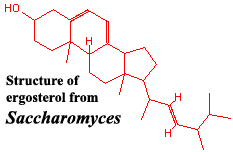 Ergosterol:
a sterol lipid which occurs in fungal cell membranes, apparently in place of
cholesterol. It is found in metazoans as a precursor to vitamin D2.
Ergosterol:
a sterol lipid which occurs in fungal cell membranes, apparently in place of
cholesterol. It is found in metazoans as a precursor to vitamin D2.
Fission: cytoplasmic division of a cell to form two cells, a form of asexual reproduction.
Fissitunicate: A bitunicate "ascus has a distinctly bilayered wall, with the outer layer being rigid and the inner layer being expandable. As it matures, the thin outer layer splits and the thick inner layer absorbs water and expands upward. The ascus stretches up into the narrow neck of the ascoma, and the ascospores are expelled. These asci with a 'jack-in-the-box' design are also called fissitunicate." Guarro et al. (1999).
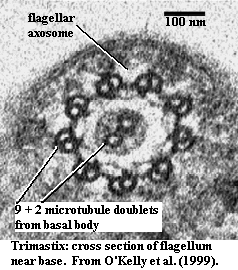 Flagellum:
(pl. flagella) A eukaryotic flagellum is a bundle of nine fused pairs of microtubules
called "doublets" surrounding two central single microtubules (the
so-called 9+1 structure of paired microtubules; also called the "axoneme"). At the base of a
eukaryotic flagellum is a microtubule organizing center about 500 nm long,
called the basal body or kinetosome. The flagellum is
encased within the cell's plasma membrane, so that the interior of the flagellum
is accessible to the cell's cytoplasm. This is necessary because the flagellum's
flexing is driven by the protein dynein bridging the microtubules all along its
length and forcing them to slide relative to each other, and ATP must be
transported to them for them to function. This extension of the cytoplasm is
called the axosome. Important note: The eukaryotic
flagellum is completely different from the prokaryote flagellum in structure and
in evolutionary origin. The only thing that the bacterial, archaeal, and
eukaryotic flagella have in common is that they stick outside of the cell and
wiggle to produce propulsion. From Flagellum - Wikipedia. Image:
O'Kelly et al. (1999).
Flagellum:
(pl. flagella) A eukaryotic flagellum is a bundle of nine fused pairs of microtubules
called "doublets" surrounding two central single microtubules (the
so-called 9+1 structure of paired microtubules; also called the "axoneme"). At the base of a
eukaryotic flagellum is a microtubule organizing center about 500 nm long,
called the basal body or kinetosome. The flagellum is
encased within the cell's plasma membrane, so that the interior of the flagellum
is accessible to the cell's cytoplasm. This is necessary because the flagellum's
flexing is driven by the protein dynein bridging the microtubules all along its
length and forcing them to slide relative to each other, and ATP must be
transported to them for them to function. This extension of the cytoplasm is
called the axosome. Important note: The eukaryotic
flagellum is completely different from the prokaryote flagellum in structure and
in evolutionary origin. The only thing that the bacterial, archaeal, and
eukaryotic flagella have in common is that they stick outside of the cell and
wiggle to produce propulsion. From Flagellum - Wikipedia. Image:
O'Kelly et al. (1999).
Fragmentation: "Many fungi can reproduce by fragmentation. Any mycelium that is fragmented or disrupted, provided that the fragment contains the equivalent of the peripheral growth zone, can grow into a new colony. Many fungi are sub-cultured using this hyphal fragment technique. All of this weeks practical plates have been inoculated in this way with a cork bore taken from a colonized donor plate. Cut mycelial tips do not regenerate, but branches can form some distance from the damage point." Reproduction in the fungi.
Fruiting body: any complex fungal structure that contains or bears spores.
Furanose: see The Cell Wall.
| Page Back | Page Top | Unit Home | Page Next |
checked ATW080206